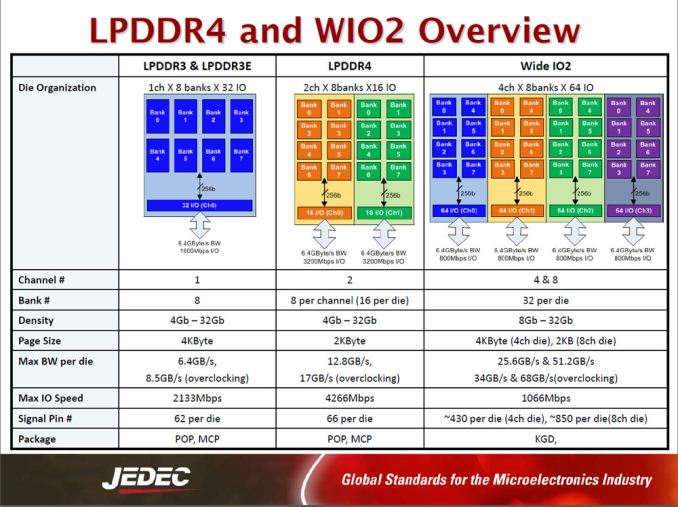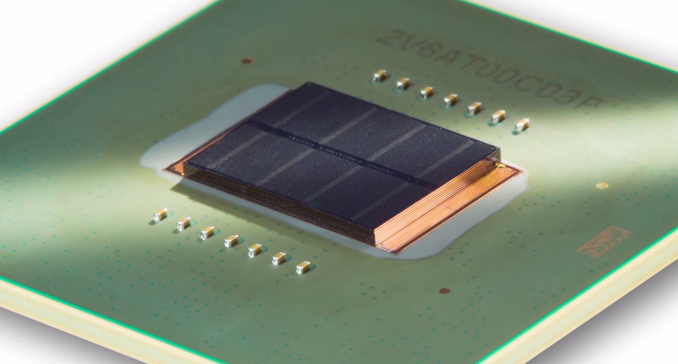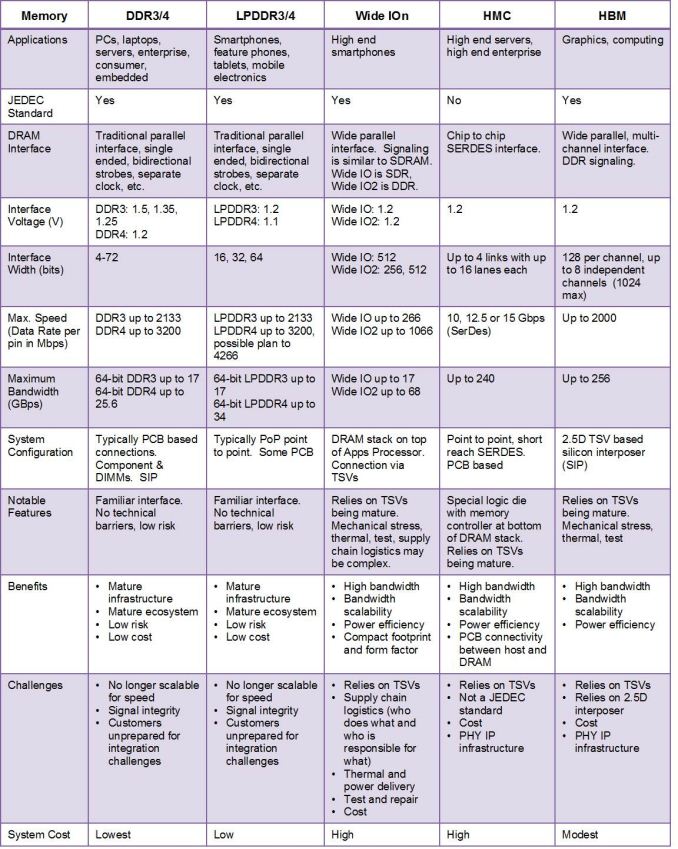DDR4 Haswell-E Scaling Review: 2133 to 3200 with G.Skill, Corsair, ADATA and Crucial
by Ian Cutress on February 5, 2015 10:10 AM ESTThe Future of DDR4
DDR4 was first launch in the enthusiast space for several reasons. On the server side, any opportunity to use lower power and drive cooling costs down is a positive, so aiming at Xeons and high-end consumer platforms was priority number one. Any of the big players in the datacenter space most likely had hardware in and running for several months before the consumer arms got hold of it. Being such a new element in the twisting dynamic of memory, the modules command a premium and the big purchasers got first pick. The downside of when that shifts to consumer where budgets are tighter and some of the intended benefits of DDR4 are not that important, such as lower power, it causes problems. When we first launched our Haswell-E piece, the cost of a 4x4GB kit of JEDEC DRAM for even a basic eight-core system was over $250, and not much has changed since. Memory companies have lower stock levels, driving up the cost, and will only make and sell more if people start buying them. At this point, Haswell-E and DDR4 is really restricted to early adopters or those with a professional requirement to go down this route.
DDR4 will start to get interesting when we see it in the mainstream consumer level. This means when regular Core i3/i5 desktops come into being, and eventually SO-DIMM variants in notebooks. The big question, as always, is when. If you believe the leaks, all arrows point towards a launch with Skylake on the Intel side, after Broadwell. Most analysts are also in this category, with the question being on how long the Broadwell platform on desktops is to last. The 14nm process node had plenty of issues, meaning that Q1 2015 is when we have started to see more Core-M (Broadwell-Y) products in notebooks and the launch of Broadwell-U, aiming at the AIO and mini-PC (such as the NUC and BRIX) market as well as laptops. This staggered launch would suggest that Broadwell on desktops should be due in the next few months, but there is no official indication as to when Skylake will hit the market, and in what form first. As always, Intel does not comment on unreleased product when asked.
On the AMD side of the equation, despite talks of a Kaveri refresh popping up in our forums and discussions about Carrizo focusing only on the sub-45W market with Excavator cores, we look to the talk surrounding Zen, K12 and everything that points to AMD’s architecture refresh with Jim Keller at the helm sometime around 2016. In a recent round table talk, Jim Keller described Zen as scaling from tablet to desktop but also probing servers. One would hope (as well as predict and imagine) that AMD is aiming for DDR4 with the platform. It makes sense to approach the memory subsystem of the new architecture from this angle, although for any official confirmation we might have to wait a few months at the earliest when AMD start releasing more information.
When DDR4 comes to desktop we will start to see a shift in the proportions of the market share that both DDR4 and DDR3 will get. The bulk memory market for desktop designs and mini-PCs will be a key demographic which will shift more to an equal DDR3-DDR4 stage and we can hope to achieve price parity before then. If we are to see mainstream DDR4 adoption, the bulk markets have to be interested in the performance of the platforms that require DDR4 specifically but also remain price competitive. It essentially means that companies like G.Skill that rely on DRAM sales for the bulk of their revenue have to make predictions on the performance of platforms like Skylake in order to tell their investors how quick DDR4 will take the market. It could be the difference between 10% and 33% adoption by the end of 2015.
One of the questions that sometimes appears with DDR4 is ‘what about DDR5?’. It looks like there are no plans to consider a DDR5 version ever for a number of reasons.
Firstly, but perhaps minor, is the nature of the DRAM interface. It relies on a parallel connection and if other standards are indicative of direction, it should probably be upgraded to a serial connection, similarly as how PCI/PCI Express and PATA/SATA has evolved in order to increase throughput while at the same time decreasing pin counts and being easier to design for the same bandwidth.
Secondly, and more importantly, are the other memory standards currently being explored in the research labs. Rather than attempt to copy verbatim a piece from ExtremeTech, I’ll summarize it here. The three standards of interest, whilst mostly mobile focused, are:
Wide I/O 2: Designed to be placed on top of processors directly, abusing a larger number of I/O pins by TSVs, keeping frequencies down in order to reduce heat generation. This has benefits in industries where space is at a premium, saving some PCB area in exchange for processor Z-height.
Hybrid Memory Cube (HMC): Similar to current monolithic DRAM dies but using a stacked slice over a logic base, allowing for much higher density and much higher bandwidth within a single module. This also increases energy efficiency, but introduces higher cost and requires higher power consumption per module.
High Bandwidth Memory (HBM): This is almost a combination of the two above, specifically aimed more at graphics by offering multiple DRAM dies stacked on or near the memory controller to increase density and bandwidth. It is more described as a specialized implementation of Wide I/O 2, but should afford up to a 256GB/s bandwidth on a 128-bit bus with 4-8 stacks on a single interface.
Image from ExtremeTech
Moving some of the memory power consumption onto the processor directly has thermal issues to consider, which means that memory bandwidth/cost might be improved at the expense of operating frequencies. Adding packages onto the processor also introduces a heavy element of cost, which might leave these specialist technologies to the super-early adopters to begin with.
Given the time from DDR4 being considered to it actually entering the desktop market, we can safely say that DDR4 will become the standard memory option over the next four years, just as DDR3 is right now. Beyond DDR4 is harder to predict, and depends on how Intel/AMD want to approach a solution that offers higher memory bandwidth, depending at what cost. Both companies will be looking at how their integrated graphics are performing, as that will ultimately be the best beneficiary to the design. AMD has some leverage in the discrete GPU space and will be able to transfer any knowledge used over to the CPU side, but Intel has a big wallet. Both Intel and AMD has experimented with eDRAM/SRAM as extra level caches with Crystal Well and PS4/XBone, which puts less stress on the external memory demands when it comes to processor graphics, which leads me to the prediction that DDR4 will be here in the market longer than DDR3 or DDR2.
If any of the major CPU/SoC manufacturers want to invest heavily in Wide I/O 2, HBM or HMC, we will have to wait. If it changes what we see on the desktop, the mini-PC or the laptop, we might have to wait even longer.













120 Comments
View All Comments
JlHADJOE - Thursday, February 5, 2015 - link
Will be interesting to see another article like this when we have CPUs with integrated graphics and DDR4.OrphanageExplosion - Thursday, February 5, 2015 - link
"For any user interested in performance, memory speed is an important part of the equation when it comes to building your next system."Doesn't your article actually disprove your initial statement?
And surely your gaming benchmarks might make more sense if - once again - you actually tested CPU intensive titles as opposed to the titles you've tested? The GPU will barely touch your expensive DDR4, if at all.
The only scenario I can see DDR4 making a real difference will be in graphics work with AMD APUs, and even then we'll need to see really high-end, fast kits that should just about offer comparable bandwidth with the slowest GDDR5 to offer a literally game-changing improvement.
Sushisamurai - Thursday, February 5, 2015 - link
Errr... Memory speed did make a difference (small IMO) when it came to DDR3. This article tests if it holds true to DDR4 - however, without an iGPU the other tests don't really show a significant difference when price is factored in. I mean, sure, there's a difference, but not worth the price premium IMO.A future AMD comparison would be nice, when AMD decides to support DDR4... Otherwise, it was a nice article.
FlushedBubblyJock - Sunday, February 15, 2015 - link
That's called the "justify wasting my life to write this article, tag and hook and sinker line, plus the required tokus kissing to the kind manu's that handed over their top tier for some "free" advertising and getting out the word.It's not like the poor bleary eyed tester can say: " I didn't want to do this because one percent difference is just not worth it, my name is not K1ngP1n and I'm not getting 77 free personal jet flights this year to go screw around in nations all over the world.
vgobbo - Thursday, February 5, 2015 - link
I really enjoyed this review!But... Intel processors are massive cache beasts, which reduces a lot the pressure put on memory (except for games, which I believe was the most interesting part of this review). Said that, I wish to see a review on an AMD system, which have a lot weaker cache structure and memory buses.
Is this possible to happen, or I'm just a dreamer? ;D
Anyway, this was another outstanding review of Anandtech! Loved it! Thank u guys!
dazelord - Thursday, February 5, 2015 - link
Interesting, but isn't Haswell-E/X99 accessing the memory in 256bit mode using 4 dimms? I suspect the gains would be much more substantial in 128bit/ 2 dimm systems.willis936 - Thursday, February 5, 2015 - link
Good stuff but after seeing a fair bit of memory roundups in my time I think this mostly confirms what everyone has been thinking: DDR4 is incredibly underwhelming in the performance space. You not only get better bang for buck with DDR3 right now but comparable, if not better, performance in the high end kits.galta - Thursday, February 5, 2015 - link
You've got it wrong. Nobody goes for DDR4 because of the memory, it's because of the new CPU and chipset.Ask yourself: do you really need extra cores and/or pci lanes? Or, do you want them and have the money to pay for it? If the answer is "yes" than you'll go for 5xxx and DDR4 is incidental.
Otherwise, go 4xxx and DDR3 will also be incidental.
It makes no sense to talk about memory as if it could be chosen independently from CPU/chipset.
rmh26 - Thursday, February 5, 2015 - link
Ian could you post more information about the NPB fluid dynamics benchmark. Specifically which benchmark CG, EP, FT ... and which class problem S, W, A, ...etc. In my own research I have found the simulation time to scale nearly linearly with the memory frequency for large enough problems. I am wondering how much the cache has to do with masking the effects of memory frequency on performance. As a the size of the problem gets larger the cache will no longer be able to mask the slowness of the memory. In general memory, and moreover interconnects between computers play a very important role in some HPC applications the rely on solving partial differential equations. In fact there have been suggestions to move away from the standard HPC Linpack benchmark used to create the top 500 lists as this compute intensive benchmark does not accurately reflect the load placed on supercomputers.http://insidehpc.com/2013/07/replacing-linpack-jac...
Dasa2 - Thursday, February 5, 2015 - link
Congrats anandtech you screwed up another ram review further misleading peopleThe games you chose to review are so badly GPU bottlenecked its sad. Do you not know that ram performance affects cpu performance?
You could run Dirt 3 with a i3 2100 vs a 5ghz 5960x and get the same score
How about putting some different CPU in amongst your ram benchmarks like 4460-4690 5820-5960x so people can see how faster ram compares to spending more on the CPU...
A 4690k with 1600c11 ram can perform slower in games than a 2500k with 2133c9 ram